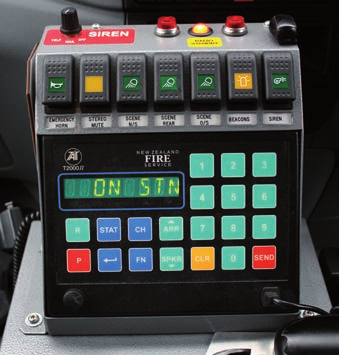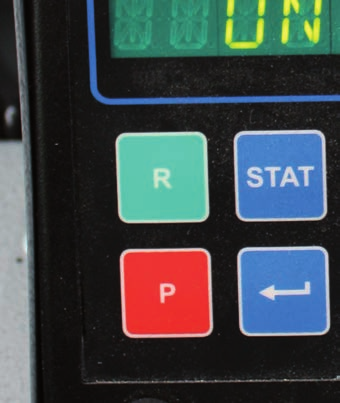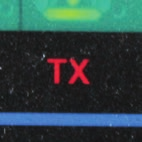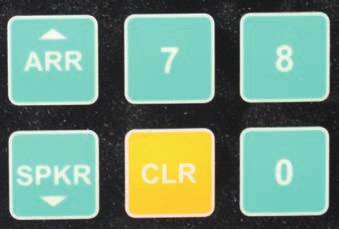 45
Topic 3: Radio skills
45
Topic 3: Radio skills July 2017
Land Mobile Radio (LMR)
Key words
priority call
a communication that
Our appliances and support vehicles carry an LMR. This is attached to a
is more important
vehicle. It is used to communicate with the Comcen.
than any other
The OIC is responsible for communicating with the Comcen. Often, the
driver/pump operator (No. 3) will relay messages from the OIC to the
Comcen using the LMR.
You need to know how to place a
priority call using an LMR, in case you
1982
are the only person able to call for assistance.
Act
Your station should have a
copy of the guide to the LMR.
It is recommended you read
this because it provides a clear
explanation on the use of this type
of radio.
When you press in a command or
code, the screen will flash up words
telling you what that command is.
Information
Official
the
under
Released
Volunteer Recruit Programme | Module 5: Incident Ground Skills
46
Topic 3: Radio skills July 2017
To make a call
Key words
transmission the delivery of a
The LMR has two types of
transmission:
message or signal
• tone transmission, known as Selcall
Comcen
person at Comcen
• voice transmission.
operator
who takes calls and
messages and sends
what the firefighters
on the incident
ground need
Tone transmission
routine
ordinary; not special
Tone transmissions use a series of tones (beeps) to send codes between
the Comcen and appliances. Codes are used to reduce the number of
voice transmissions that are made. The tone transmission sent by pressing
the priority button sounds an alarm at the Comcen to get the attention of
the
Comcen operator.
Voice transmission
Voice transmission means using your voice to communicate from an
appliance or support vehicle to the Comcen (or from the Comcen to the
appliance or support vehicle).
There are two types of voice transmission:
•
routine call, the normal kind of transmission
• priority call, a transmission that is more important than any other call.
under the Official Information Act 1982
Released
Volunteer Recruit Programme | Module 5: Incident Ground Skills


 47
Topic 3: Radio skills
47
Topic 3: Radio skills July 2017
How to use voice transmission
1. Send a tone transmission to
Comcen requesting permission to
use voice transmission.
To do this, press either the:
• R button (for a routine call
request) or
1982
• P button (for a priority call
request).
2. The Comcen operator gets the
Act
signal and will contact you as soon
as they can.
Information
Priority call requests (P) sound an alarm in the Comcen and always
get answered before routine calls.
3. The Comcen responds to
the appliance by voice. When
Clevedon
responding, Comcen will use the
Official
421, go
ahead.
call sign for the appliance, for
example, ‘Clevedon 421’.
the
4.
under
Use the LMR microphone or
handset to pass your message to
Comcen.
Released
Volunteer Recruit Programme | Module 5: Incident Ground Skills
 48
Topic 3: Radio skills
48
Topic 3: Radio skills July 2017
If you have to make a priority call request
Unless specifically ordered by the OIC to send a message, you would only
need to use the LMR to send a message if you were the only firefighter
able to send a call for help. This could happen if other members of your
crew were injured.
If you have to make a priority call:
1. Decide what you have to say first. Calling for help using a priority call
is like making a 111 call. You must tell the Comcen operator what has
happened and if anyone is injured. You may also need to tell them exactly
where you are.
2. Follow the steps for ‘How to place a priority call request’.
3. Give your message when the Comcen operator contacts you.
How to place a priority call request
1. Press the P button on the LMR.
The radio automatically makes five
attempts to send the request.
under the Official Information Act 1982
continued over page
Released
Volunteer Recruit Programme | Module 5: Incident Ground Skills



 49
Topic 3: Radio skills
49
Topic 3: Radio skills July 2017
2. You will know the call request
has been sent because:
• the radio beeps twice
• the TX light (transmit indicator)
goes on, then off
• PRIORITY flashes on the display
screen.
1982
If none of this happens, you haven’t
pushed the button, or the radio is
switched off.
Act
3. Check your call has gone
through.
Beep,
Beep
YES
If the call request gets to Comcen:
Information
• the radio beeps twice
• the display stops flashing
• the display screen will show
PRIORITY.
Official
the
NO
Beep,
Beep,
If the call request
cannot get
Beep,
Beep,
through to Comcen:
Beep
• the radio beeps five times
• the PRIORITY display stops
under
flashing.
If the call request does NOT get
through the first time, the radio will
automatically try four more times.
Released
Volunteer Recruit Programme | Module 5: Incident Ground Skills
 50
Topic 3: Radio skills
50
Topic 3: Radio skills July 2017
4. If, after five automatic tries, the
call request has not gone through
to Comcen, press the CLR button.
This resets the radio. Next, you
can:
a) try again (from Step 1)
b) change channels then try again
1982
c) move to a location with better
reception, then try again.
Act
Codes
Sometimes it can be helpful to use codes to quickly communicate a
situation. We uses codes to communicate several things on the Land
Mobile Radio (LMR) network, such as:
Information
• the status of a vehicle
• arrival messages
• the condition of a casualty.
Official
the
under
Released
Volunteer Recruit Programme | Module 5: Incident Ground Skills
 51
Topic 3: Radio skills
51
Topic 3: Radio skills July 2017
K codes
Key words
K codes are used to communicate
K codes
code messages used
when using radios in vehicles.
to advise the Comcen
of fire appliance or
Here are K codes you are likely to
personnel status
come across.
1982
NOTE
Code
Meaning
Act
A complete list of all K codes
K1
Proceeding to incident
can be found in every fire
appliance.
K2
In attendance at incident
K7
At normal station
K11
Requesting a service
(You need to say what service is required and
the reason, if necessary.)
Information
K11-1
Police required – confidential
K12
Suspicious nature (deliberate with intent to
cause damage)
Official
K55
First appliance in attendance – special service
incident
the
K66
First appliance in attendance – non-property
fire
K77
First appliance in attendance – nothing
showing, investigating further
under
K88
First appliance in attendance – property fire,
apparently small
K99
First appliance in attendance – property fire,
well involved
Released
Volunteer Recruit Programme | Module 5: Incident Ground Skills










